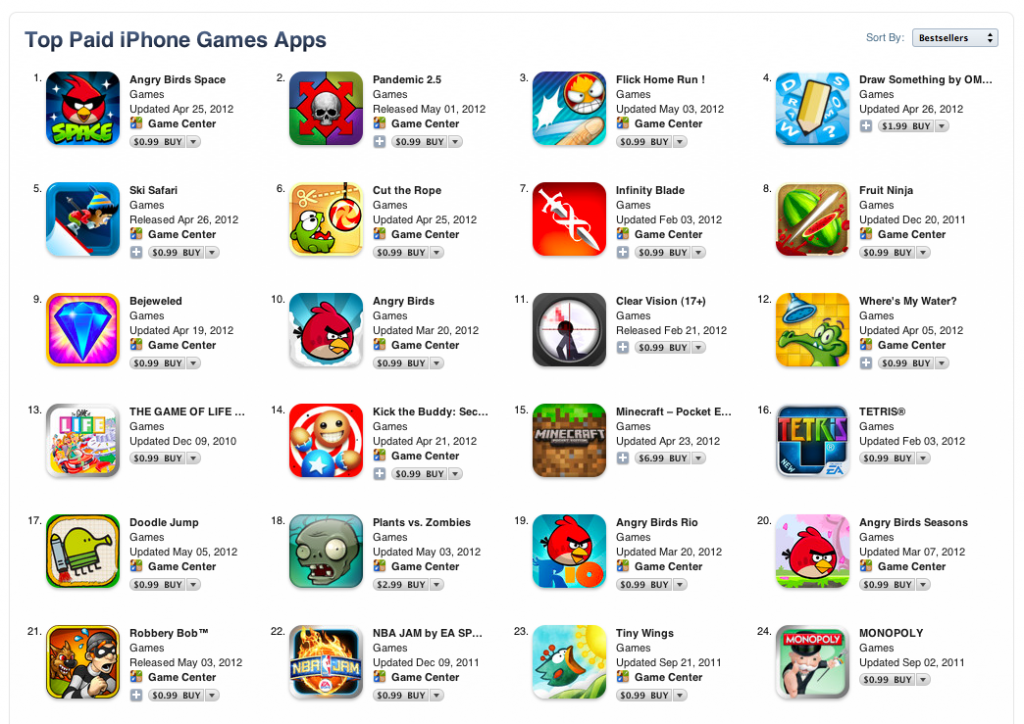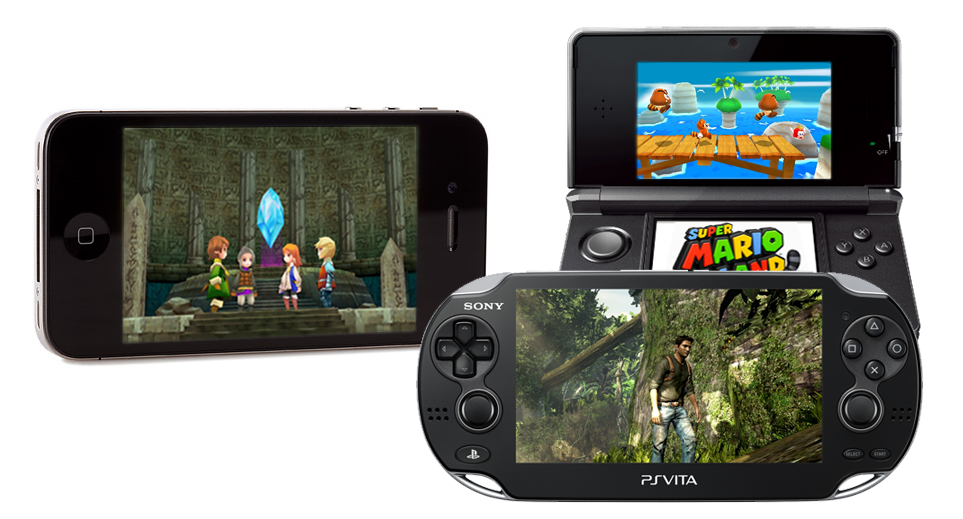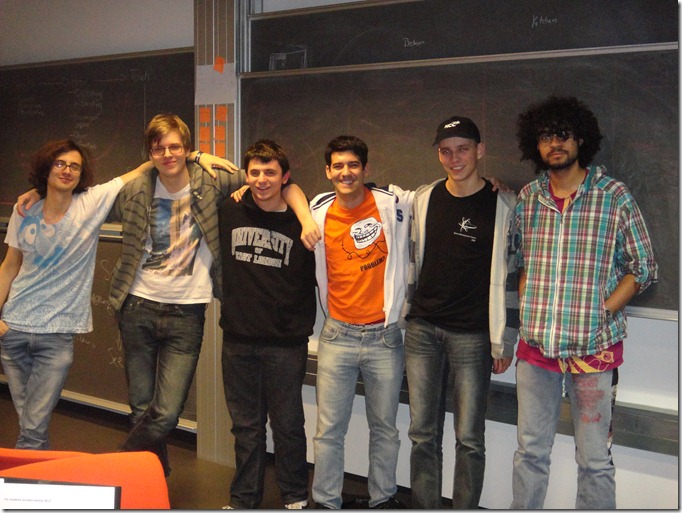Earlier today someone on Facebook asked about the growing discussion that handheld consoles like the Nintendo 3DS and the PS Vita are slowly fading away, getting lost in the incredibly successful market of smartphones and tablets like the iPhone and iPad. I replied with a very long comment for a Facebook post and I thought that I could re-purpose my text for a new post here.
The thing here is that there’s no doubt now that smartphones and tablets are affecting the sales of handheld consoles. They are still not killing the market, but the incredibly slow start the Nintendo 3DS had until known franchises came to it and the big struggle the PS Vita is currently having on the market are signs that things have changed.
Taking that into account, what is the current audience of handhelds? What are the reasons one might buy a dedicated gaming console instead of a smartphone or tablet?
Let’s begin with the one age group that smartphones and tablets are still a long way from breaking into, and that is the younger audience under 14 years old. You wouldn’t buy a 10 year old kid an iPhone, a highly expensive device that is easy to break and get stolen, but you might buy him a Nintendo DS with a Super Mario game or the latest movie tie-in like a Spiderman game or a Disney character in it.
In fact, when you look at the age demographics of the iPhone and iPod Touch you can see that the age group of users from 13 to 17 years old is tiny (6%) when compared to that same age group in the iPod Touch demographics (46%) (Source from 2009). You could consider the iPod Touch as a game handheld if you will. After all it has access to apps and games, which is the main reason these users choose the iPod Touch over the more traditional iPods which are almost exclusively used to play music. Same goes for the Nintendo DS/3DS and (in a smaller way since it goes for a more mature audience) the PS Vita. They offer cheaper, contract-free devices with gaming as their main purpose and, in the mindsets of buyers, a better value proposition for a kid than an iPhone. You could add Android phones here if you want, but currently there are no low-end Android devices that could cover this space, since the cheap devices that do exist are simply too low-powered for modern phone games.
But of course that’s not the only audience of handheld consoles. When you go to ages 14+ both the DS/3DS and PSP/Vita offer a nice choice of games aimed squarely at this audience. You have Metal Gear Solid, Uncharted, Resident Evil, Silent Hill, God of War, Final Fantasy… However, and this is where the sales have been going down, those handhelds now have to compete with smartphones and, to a lesser extent (simply because not everyone sees value in having a device that some feel is a bigger smartphone), tablets.
But here is the thing, and it’s a point most media outlets seem to be missing. Let me explain a little bit first: smartphones have absolutely nothing blocking them from running blockbuster titles of the same quality as those mentioned above (touch controls aside). You just have to take a look at what French company Gameloft has been doing in the past few years, taking popular gaming franchises and creating equivalents of them for phones (N.O.V.A is a Halo clone, Modern Combat 3 is Modern Warfare 3, Hero of Sparta is God of War, StarFront is StarCraft…) or taking Ubisoft staples into bite-sized chunks (Prince of Persia, Splinter Cell, Brothers in Arms).
BUT!
Those games coexist in a marketplace full of extremely cheap offers of $0.99, the new standard for game prices (something neither Nintendo or Microsoft are very keen on, claiming it devaluates videogames as a whole). This means that if a company wanted to make a full size game with the same length, depth and quality as a console or handheld game they would need to price it higher to cover the production costs. And that simply doesn’t sell very well in a flood of $0.99 titles. Gameloft and EA are able to pull that off thanks to their use of big franchise names, but even then the prices don’t usually go higher than $6.99, and they quickly drop after the hardcore fans of the series have already bought it so as to attract the rest of the market.

The top 10 paid games on the US AppStore as of May 2012
The other company that is managing to pull off higher prices for its games is Square-Enix. $15.99 for a port of a DS Final Fantasy game (Final Fantasy III), which was already a remake of an old NES game. But Final Fantasy games have the advantage of being really deep and lengthy adventures (thus the price) that don’t require very precise control input: just tap and wait for the battle animation to finish.
That’s where handhelds come in for those who want a more serious gaming experience. You get the more precise controls for action games and the higher production values, with almost console-quality graphics, story and gameplay depth in a smaller package that you can take anywhere you go.
For those who want an all-around device that does everything an iPhone will be the only device to carry around at all times. But those who want a deeper experience on the go (and I’m not talking about just something to play on the train, but also when visiting their parents for a week, going on a trip and so on) will also carry with them a handheld.
Plus, now these gaming handhelds get the added experience of buying smaller games at cheaper prices, smartphone style. The 3DS will allow you to buy old Gameboy and NES games as well as new, modern titles for under $5. The PS Vita lets you download casual games like Angry Birds or get an old PS One game like Crash Bandicoot at the same price level. And at the same time you get the full range of top-tier new releases (which tend to be more on the $40 range), some as physical copies, some as downloadable games too (specially now that Nintendo is going to make their 3DS and Wii U games available online as well).
And then finally you have the more mature audiences that as far as I know only Nintendo has been able to attract so well thanks to their Brain Training series. But that’s usually the group that buys only one game or two and leaves it there.
Anyway, those are my 2 cents on the topic. It’s mostly based on my own thoughts and experience, but I believe I’m not too far off the reality. Of course I’m basing myself on articles, opinions, comparisons and a few stats, but you could hardly call every single one of those hard facts, so all this could be wrong.
But the fact is that the landscape of gaming on the go has severely changed and both Nintendo and Sony will have to step their game up if they want to survive in a market full of $0.99 games that, in the mind of many casual consumers, offers as much value as any $40 game.







